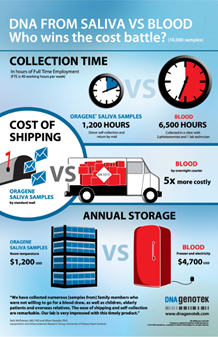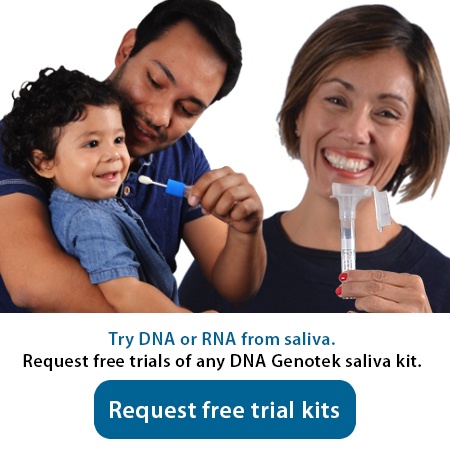2019-05-22
Many researchers have asked the question: can saliva replace blood for DNA collection and analysis? Research studies confirm that DNA from saliva is equivalent to DNA from blood for analysis; however, when it comes to maximizing research budgets it is also important to consider the costs of the sample type you are using.
Compared to blood DNA collection, saliva has been shown to be 48% less costly than blood [1]. The important question is: why is the cost of blood collection so high? Many labs are already equipped to collect and process blood samples and this may be perceived as more economical, however there are many hidden costs associated with blood that researchers and clinicians should consider. In this blog we will explore the hidden costs of blood collection.
Donor compliance and recruitment
Donor recruitment is one of the most challenging aspects of a research project. Researchers require a sample type that fosters a high participation rate and improves access to donors to keep collection costs to a minimum[2].
During the recruitment stage, researchers hope to quickly reach their desired cohort number. In order to reach that number, it is important to have a sample collection process with high donor compliance and accessibility.
Blood is often viewed as the standard for collecting high quality DNA, however studies point out that invasive venipuncture is the main reason for recruitment refusal. Additionally, blood collection requires access to clinical infrastructure. Both of these factors are associated with increased costs [1][3]. Saliva is a reliable sample type for high quality DNA and has proven advantages over blood (see table 1). Researchers save time and effort on recruiting donors for saliva collection and are more likely to spend less on donor incentives.
Studies have shown that blood collection is estimated to have 30% donor compliance even when combined with financial incentives. With saliva, it is common to achieve compliance rates of 70-95% without added donor incentives – that’s a 200% increase in donor compliance compared to blood. [1] [2] [4].
Additionally, blood collection requires trained personnel such as a phlebotomist, adding to the cost; whereas, saliva can be self-collected in a donor’s home, at an event or in remote locations [1].
Table 1. Saliva using Oragene® versus blood for DNA collection.
|
Blood |
Saliva (using Oragene®) |
|
Invasive |
Non-invasive |
|
Disliked by subjects (impractical for children); low donor participation rate |
Easy to use (practical for children); high donor participation rate |
|
Requires a trained phlebotomist |
Does not require trained personnel to collect the sample |
|
Requires refrigeration and rapid processing (less than a week) |
Can be stored at room temperature |
|
Requires cold chain transportation or in clinic collection |
Can be collected at home and mailed back through regular post |
|
Expected compliance rate: 30% [4] |
Expected compliance rate: 70-95%[4] |
Costs of transportation and storage

Blood can be suitably stored for many years at -80 and -120 degrees Celsius, however, storing blood samples at these temperatures adds significant freezer costs per sample - costing more if you need to redraw the samples from the freezer (about $62 USD per hour) [5]. If a freezer is not already installed, a lab grade freezer can cost up to $7000 USD [1].
In terms of transport, blood samples require dry ice, express/overnight shipping and multiple containers, on average costing $80 USD per sample [1][6][7].
Some blood specific all-in-one insulated shipping container packages can cost around $77 for only 5 tubes of blood, for 500 tubes of blood it would cost over $7700 USD. The least costly alternatives are just simple containers that require additives such as insulation which can add up to be the same cost or even more [6]. Dry-ice for 100 blood samples can cost over $600 [1]. Blood needs to be extracted soon after collection, therefore, it is necessary to ship the blood samples overnight/express to the lab in order to maintain DNA stability. Shipping to a central location in the USA can range from $40-60 USD via Express UPS [7].
Oragene/saliva samples in comparison, can be stored at room temperature for years without DNA degradation and shipped via regular mail (full shipping details are found here.) All in all, shipping blood samples is 5x more costly than shipping saliva.
Table 2. Requirements to transport and store blood vs saliva [6][7][8].
|
Requirements to transport and store blood |
Requirements to transport and store saliva* (using Oragene®) |
|
Average cost to ship: ~$80 USD / sample |
Average cost to ship: ~$5 USD / sample |
|
Dry ice |
Leak-proof baggie with absorbent material |
|
Containers:
|
Envelope labelled “exempt human specimen” |
|
Express or overnight shipping |
Regular / standard shipping |
|
Storage: Lab grade freezer |
Storage: Room temperature [9] |
*Saliva sample not to be expected to be pathogenic
DNA quality and extraction
Obtaining high quality DNA from a sample is crucial for research and clinical applications, especially if you are storing your samples prior to extraction. Anthonappa et al (2013). conducted an evaluation study of DNA quality from blood and saliva samples stored in various conditions [3]. The mean yield obtained from the saliva samples was significantly higher than that obtained from blood. The average DNA yield from a 2ml saliva sample was 116 ng/μl, which was approximately twice the average yield of blood per the same volume. In order for blood to render high quality DNA, it must be extracted immediately or stored at -20ºC or –80ºC. However, Anthonappa et al (2013). learned that when stored over time, even at -20ºC, the quality of blood decreases [3].
Saliva collected using Oragene® stabilizes DNA at room temperature for years with no signs of degradation. The DNA within an Oragene/saliva sample can also withstand multiple freeze thaw cycles and extreme temperature fluctuations during transport (-20ºC to +60ºC). When you lose DNA quality, it can result in failed samples which can be costly when using expensive downstream applications (such as sequencing) and also require additional recruitment to re-collect. To avoid low quality DNA and lost samples, ensuring effective sample stability is key [9].
In terms of DNA extraction, both blood and saliva are comparable in terms of cost/sample, as long as sample stability has been taken into account. Oragene/saliva samples can be processed with any manual preparation method, including DNA Genotek’s purification reagent prepIT⋅L2P which is designed for optimal recovery of high quality DNA. Furthermore, Oragene/saliva samples can be extracted with high through-put technology for further lab efficiencies and cost savings.
Conclusion
The cost to collect, transport, extract, and freeze blood samples quickly adds up, especially for large cohorts. It is important to choose the right sample type for your genomic research to save on unnecessary collection and transport costs and to facilitate cost-effective long term storage. Oragene·DNA saliva kits meet the demands of a non-invasive, accessible sample type, that can be shipped and stored at room temperature – all while delivering reliable high quality DNA [3].
We love hearing our readers’ experiences with various sample types – please leave us a comment. If you are interested in trying Oragene saliva samples for your own project, click on the free kits request button below or email info@dnagenotek.com.
 Related Blogs:
Related Blogs:
- Can saliva replace blood for DNA collection & analysis? (Part 1 of 3)
- Rinse, Swab or Spit: What’s the real source of DNA in saliva?
- Best Practices for Long-term Storage of Oragene•DNA Samples
- The power of ambient temperature sample shipping and storage
- Storage of Purified DNA from Oragene•DNA Samples
References:
[1] Davis R et al. Specimen collection within the CRN: a critical appraisal. CRN (2010).
[2] https://www.dnagenotek.com/US/pdf/MK-006.pdf
[3] Anthonappa et al. Evaluation of long-term storage stability if saliva as a source of human DNA. Clin Oral Invest 17:1719-1725 (2013).
[4] https://www.dnagenotek.com/US/saliva-is-easier.html
[5] NTNU HUNT and CONOR Project Price List. (2017). https://www.ntnu.edu/documents/140075/1268289603/Price+list_NTNU+or+CONOR+assignments_HUNT+biobank+2017.pdf/5f3fbb0a-a45a-4a74-a761-8f7364156e3b
[6] https://www.uline.ca/BL_2157/Insulated-Shipping-Kits
[7] http://williamlabs.com/wp-content/uploads/2018/03/packmaxq-whitepaper.pdf
[8] https://www.ups.com/us/en/shipping/services/domestic/overnight-delivery.page

